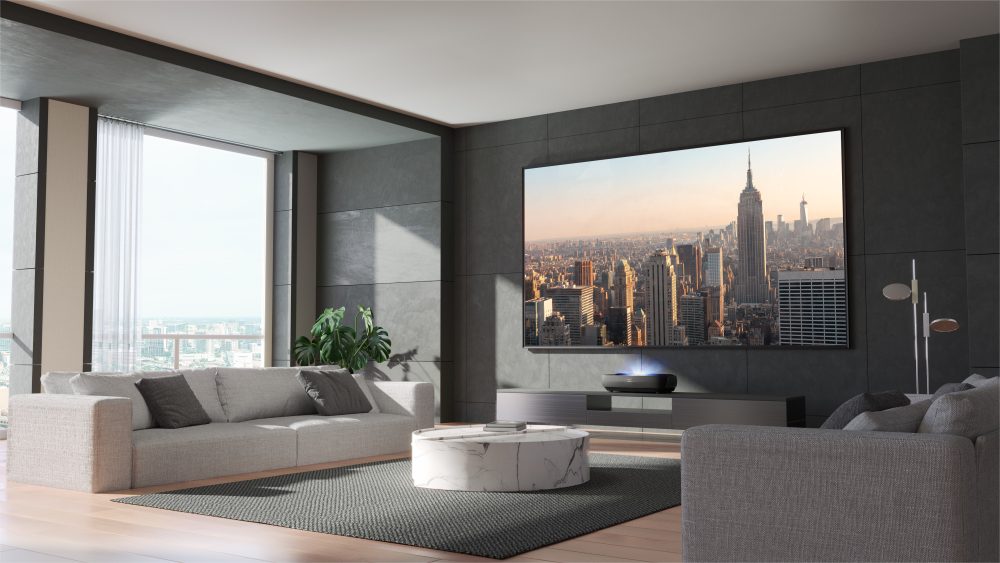Ultra-short throw (UST) projectors are pushing the boundaries of how the consumer tech industry approaches TVs. The devices operate by bouncing images through a series of mirrors to project a super-sized image at a vertical angle.
Hisense has been a leader in the UST projector market since 2017 and is one of the only companies to sell its UST projectors not as a standalone item, but in conjunction with a unique ambient light rejecting (ALR) screen to optimize picture quality.
In regards to the importance of having a dedicated combination setup, Kenneth Welty, the director of Laser TVs at Hisense USA, said, “A lot of manufacturers don’t include the screen. They leave that up to the consumer … You can certainly put it on a wall, and it looks ok. You can use just a regular white screen and again, it looks ok. But when you use it with an ALR screen because of the technology that’s built into it, you’re going to be able to maximize your picture quality with that screen.”
Hisense creates its ALR screens specifically for its UST projectors, which optimizes results for the highest quality picture. The projector sits directly below the screen and shoots images up onto it, while pulling the ambient light around it downward. This allows the screen to be used in the light and the dark, making it a great option for multiple settings.
The screen comes in 100- and 120-in. versions that weigh around 35 pounds and only stick out from the wall about one inch. Comparable TVs of that size typically weigh around 300 pounds and often stick out 6 inches or more. The projector comes in a single laser and triple laser model, which both produce 4K images.
“Our goal is to have this category replace the living room TV set,” said Welty. “You can sit right in front of the screen, and it can be put in a very brightly lit room because of the ambient light rejecting screen. It’s got sound built into it. It’s got a TV tuner built into it. It’s got a smart platform built into it. So, it is a TV.”
The screen’s light weight makes it much easier to install than more traditional sets, like OLED and LCD TVs. Setting up the screen only requires installing two small brackets on the wall and placing the screen into them. There is also no need for an electrician, because there’s no electrical components in the back of the screen.
Having a product like the Hisense Laser TV that offers such easy installation and a large screen with excellent picture quality makes it a great product for retailers to offer to consumers.
“By bringing in a set like this, not only are you more in control, but the other aspect is you get a lot more flexibility with where you can decide to put a product like this,” said Fred Towns, president of New Age Electronics. “The consumer is experiencing an easier application with no degradation of picture.”
The single laser projector comes equipped with a 30-watt Dolby speaker system, while the triple laser has a 40-watt. The setup can be upgraded to WiSA Speakers, such as Klipsch or Enclave. There’s also plenty of opportunity to upsell other items along with it, including the stand and audio or video receivers.
Another area where the setup excels is gaming. The large screens provide an immersive gaming experience, and the game mode provides optimal picture quality with a fast response time. The setup has an auto-response time that is typically 10 times faster than OLED TVs.
The Hisense Laser TV has a lifespan of 25,000 hours thanks to its DLP chip, which translates to four hours of watch time a day for 18 years. It also only costs 1/5 the price of a traditional LCD 100-in. unit.
“This is groundbreaking technology that really will allow consumers to get that bigger screen in their home,” said Welty. “Try to get an 80-in. or a 100-in. panel on an elevator in New York City – it’s not going to happen. But certainly, carrying the screen up and then assembling it and putting it on a wall, which is very simple to do, can happen.”
To check out more of the conversation in this edition of Insider Talk, click here.















